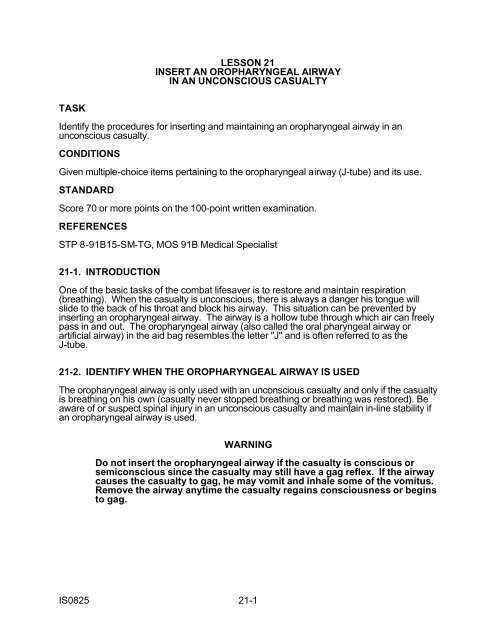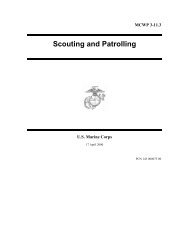US-Army-IS-0825-medical-course-Combat-Lifesaver-Course-0825CC1
US-Army-IS-0825-medical-course-Combat-Lifesaver-Course-0825CC1
US-Army-IS-0825-medical-course-Combat-Lifesaver-Course-0825CC1
Create successful ePaper yourself
Turn your PDF publications into a flip-book with our unique Google optimized e-Paper software.
LESSON 21<br />
INSERT AN OROPHARYNGEAL AIRWAY<br />
IN AN UNCONSCIO<strong>US</strong> CASUALTY<br />
TASK<br />
Identify the procedures for inserting and maintaining an oropharyngeal airway in an<br />
unconscious casualty.<br />
CONDITIONS<br />
Given multiple-choice items pertaining to the oropharyngeal airway (J-tube) and its use.<br />
STANDARD<br />
Score 70 or more points on the 100-point written examination.<br />
REFERENCES<br />
STP 8-91B15-SM-TG, MOS 91B Medical Specialist<br />
21-1. INTRODUCTION<br />
One of the basic tasks of the combat lifesaver is to restore and maintain respiration<br />
(breathing). When the casualty is unconscious, there is always a danger his tongue will<br />
slide to the back of his throat and block his airway. This situation can be prevented by<br />
inserting an oropharyngeal airway. The airway is a hollow tube through which air can freely<br />
pass in and out. The oropharyngeal airway (also called the oral pharyngeal airway or<br />
artificial airway) in the aid bag resembles the letter "J" and is often referred to as the<br />
J-tube.<br />
21-2. IDENTIFY WHEN THE OROPHARYNGEAL AIRWAY <strong>IS</strong> <strong>US</strong>ED<br />
The oropharyngeal airway is only used with an unconscious casualty and only if the casualty<br />
is breathing on his own (casualty never stopped breathing or breathing was restored). Be<br />
aware of or suspect spinal injury in an unconscious casualty and maintain in-line stability if<br />
an oropharyngeal airway is used.<br />
WARNING<br />
Do not insert the oropharyngeal airway if the casualty is conscious or<br />
semiconscious since the casualty may still have a gag reflex. If the airway<br />
causes the casualty to gag, he may vomit and inhale some of the vomitus.<br />
Remove the airway anytime the casualty regains consciousness or begins<br />
to gag.<br />
<strong>IS</strong><strong>0825</strong> 21-1



